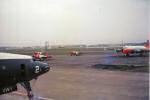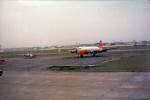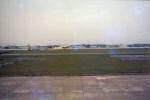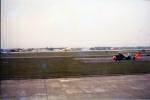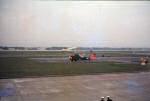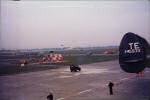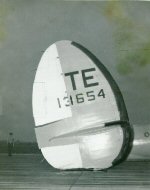In 1964 a C-121J Super Constellation was en route from Agana, Guam, to Japan with passengers aboard. The first landing was scheduled at Tachikawa AFB, Japan. The copilot was in the left seat, with the squadron CO in the right seat. The CO planned for the lieutenant, an experienced pilot, to make the approach and landing at Tachikawa.
The flight was routine. The landing gear was extended during descent for landing to expedite the descent; a little later, the gear was raised. The Super Connie was subsequently cleared for radar vectors to a ground controlled approach final. On intercepting the glide path, the wheels were lowered but the cockpit instrument indicated the nose wheel was not locked down. It was visual flight rules and the field was in sight. The skipper cycled the gear but the unsafe indication remained, so the plane waved off.
The radioman alerted the passengers there would be a delay in landing. The crew labored to get the nose wheel down, but the emergency system failed to lock the nose wheel in place. Recycling the gear didn't work, either. The CO told the copilot to concentrate on flying the aircraft while he supervised emergency procedures.
Next, after depressurizing the aircraft and vectoring over water for safety purposes the flight engineer, with
a safety line secured to him, tried to 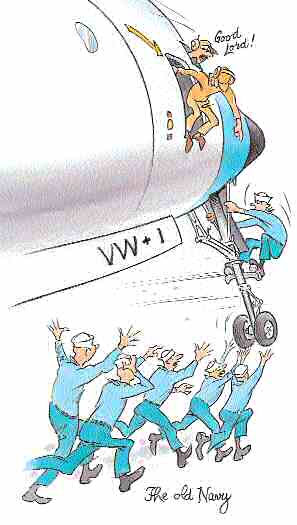 reach the nose wheel with a pole to push it into locked position. It wasn't long enough, so
a second and third pole were spliced together, but this effort also failed. The skipper decided to proceed
to NAS Atsugi, Japan, and asked the Atsugi tower to assemble key people to assist in troubleshooting the
problem. En route, the crew tried to hand pump the nose wheel down, but they were unable to achieve enough
pressure to do so. A second squadron aircraft in the vicinity joined up and confirmed the nose gear was in a
trail position. Sensing the passengers' concern, the third pilot on board calmly briefed the passengers on
what was happening. Keeping them informed alleviated their anxiety.
reach the nose wheel with a pole to push it into locked position. It wasn't long enough, so
a second and third pole were spliced together, but this effort also failed. The skipper decided to proceed
to NAS Atsugi, Japan, and asked the Atsugi tower to assemble key people to assist in troubleshooting the
problem. En route, the crew tried to hand pump the nose wheel down, but they were unable to achieve enough
pressure to do so. A second squadron aircraft in the vicinity joined up and confirmed the nose gear was in a
trail position. Sensing the passengers' concern, the third pilot on board calmly briefed the passengers on
what was happening. Keeping them informed alleviated their anxiety.
Next, the crew put the C-121J in a series of dives, attempting to rock the nose wheel into locked position. A tech rep arrived in the tower and recommended the crew secure all hydraulic pumps, slow the aircraft, then turn the pumps back on simultaneously, shifting the crossover valve to the emergency position. The theory was that the sudden surge of pressure might be enough to lock the gear down. This also failed.
After an hour and a half of troubleshooting, the CO requested that the runway be foamed for landing. It was decided to shift weight, in this case people, to move the center of gravity aft. The pilots would land on the main mounts and hold the nose up as long as possible. At touchdown, selected military personnel seated forward would walk (not run) aft to help keep the tail down and the nose off the ground. The tower had recommended a gear-up landing but the skipper rejected that option. He felt the crew could land and keep the nose wheel off the deck until forward speed fell off to about 50 knots.
The squadron's flight surgeon went from seat to seat briefing individuals on holding their heads down for the landing. An enlisted man was positioned in a seat beside each child and tasked with the safety of that child. Fifteen enlisted personnel volunteered for the forward seats. The CO recognized the risks in having people moving aft when the main mounts were firmly on the runway. He also knew that the flight engineer and radioman faced a special hazard, because at their positions near the nose gear they were subject to injury if the plan didn't work.
In the approach, the cockpit crew suddenly smelled something burning. The skipper called for an immediate landing. The burning odor faded but the flight was committed to land. The copilot was at the controls and expertly guided the transport to a firm, but not hard, touchdown at the 1,500-foot mark at 95 knots. He kept the nose high which lifted the C-121J momentarily a foot or so back into the sky. Both pilots held the yoke full aft and the copilot rolled in full back tab. The aircraft landed on centerline and slowed rapidly, and the personnel seated forward began moving aft. Rudder control was effective until the tail began to drag on the runway, grinding away the lower rudders. At 30 knots the pilots employed brakes to counter swerving motion. The tail stayed down and just as it looked like the Super Connie was going off the runway, it drew to a halt, resting on the main mounts and the tail.
Rescue personnel immediately swarmed around the transport and assisted passengers in disembarking. Crash crew personnel came on board to keep the weight in the tail. No one was hurt. The C-121J sustained minor damage.
Grampaw Pettibone says:
Although this event happened years ago, the teamwork, cool thinking and professional flying demonstrated by this aircrew was first-rate and stands as a model for today's Naval Aviation personnel.
This photo sequence of TE-00 landing nose high courtesy of Ryan Grubbs ATW3 VW-1 63 - 64 TE-3.
The B/W photo shows the minimal amount of damage to TE-00 tail section, notice that this picture was taken while the tail was still on the ground. Picture courtesy of Lowell Buswell ATW-3 VW-1 64-65 TE-5.

